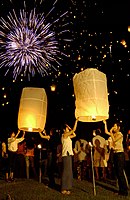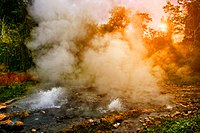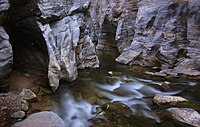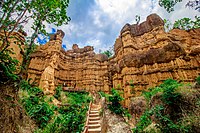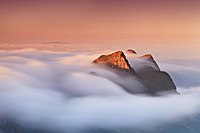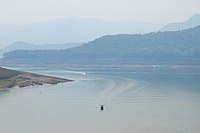Chiang Mai province
Chiang Mai
เชียงใหม่ ᨩ᩠ᨿᨦᩉᩲ᩠ᨾ᩵ | |
|---|---|
| จังหวัดเชียงใหม่ · ᨧᩢ᩠ᨦᩉ᩠ᩅᩢᨩ᩠ᨿᨦᩉᩲ᩠ᨾ᩵ | |
From left to right, top to bottom : Wat Phra That Doi Suthep, Doi Inthanon, Doi Ang Khang, Op Luang National Park, Wat Phra Singh, Chiang Mai University, Mae Sa Waterfall, Chiang Mai Zoo | |
| Nickname: Nakhonphing (Thai:นครพิงค์) | |
| Motto(s): ดอยสุเทพเป็นศรี ประเพณีเป็นสง่า บุปผชาติล้วนงามตา นามล้ำค่านครพิงค์ ("Famed Doi Suthep. Elegant traditions. Beautiful blossoms. Invaluable name of Nakhonphing.") | |
| Anthem: นครเชียงใหม่ Nakhon Chaing Mai (De facto) | |
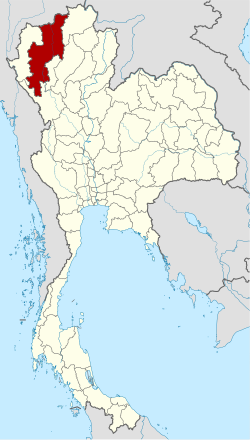 | |
| Coordinates: 18°50′14″N 98°58′14″E / 18.83722°N 98.97056°E | |
| Founded by | Mangrai |
| Capital | Chiang Mai |
| Government | |
| • Governor | Nirat Pongsitthaworn (since October 2022)[1] |
| Area | |
| • Total | 22,436 km2 (8,663 sq mi) |
| • Rank | 1st |
| Population (2022)[5] | |
| • Total | 1,792,474 |
| • Rank | Ranked 4th |
| • Density | 81/km2 (210/sq mi) |
| • Rank | Ranked 63rd |
| Human Achievement Index | |
| • HAI (2022) | 0.6179 "low" Ranked 68th |
| GDP | |
| • Total | baht 232 billion (US$8.0 billion) (2019) |
| Time zone | UTC+7 (ICT) |
| Postal code | 50xxx |
| Calling code | 052 & 053 |
| ISO 3166 code | TH-50 |
| Vehicle registration | เชียงใหม่ |
| Accession into Siam (Thailand) | 1910 |
| Website | chiangmai.go.th |
| Chiang Mai province | |
|---|---|
 | |
| Thai name | |
| Thai | เชียงใหม่ |
| RTGS | Chiang Mai |
| Northern Thai name | |
| Northern Thai | ᨩ᩠ᨿᨦᩉᩲ᩠ᨾ᩵ [t͡ɕīəŋ.màj] |
Chiang Mai[a] is the largest Province (changwat) of Thailand by area.[3][4] It lies in upper northern Thailand and has a population of 1.78 million people. It is bordered by Chiang Rai to the northeast, Lampang and Lamphun to the south, Tak to the southwest, Mae Hong Son to the west, and Shan State of Burma to the north. The capital, Chiang Mai, is 685 kilometres (426 mi) north of Bangkok.
Geography
[edit]Chiang Mai province is about 685 km (426 mi) from Bangkok in the Mae Ping River basin and is on average at 300 m (1,000 ft) elevation. Surrounded by the mountain ranges of the Thai highlands, it covers an area of approximately 22,135 km2 (9,000 sq mi). The mountains of the Daen Lao Range (ทิวเขาแดนลาว) at the north end of the province, the Thanon Thong Chai Range (เทือกเขาถนนธงชัย) with the highest mountain in Thailand, Doi Inthanon at 2,565 metres (8,415 ft), stretching in a north–south direction, and the Khun Tan Range in the east of the province are covered by rain forest. The Mae Ping, one of the major tributaries of the Chao Phraya River, originates in the Daen Lao mountains. Several national parks are in the province: Doi Inthanon,[8] Doi Suthep-Pui,[9] Ob Luang,[10] Sri Lanna,[11] Huai Nam Dang,[12] Mae Wang,[13] and Pha Daeng.[14] The total forest area is 15,404 km2 (5,948 sq mi) or 69.6 percent of provincial area.[2]
National parks
[edit]There are fifteen national parks, making up region 16 of Thailand's protected areas.
- Si Lanna National Park, 1,405 km2 (542 sq mi)[15]: 60
- Huai Nam Dang National Park, 1,252 km2 (483 sq mi)[15]: 81
- Pha Daeng National Park, 1,123 km2 (434 sq mi)[15]: 99
- Mae Ping National Park, 1,004 km2 (388 sq mi)[15]: 31
- Op Luang National Park, 553 km2 (214 sq mi)[15]: 68
- Doi Pha Hom Pok National Park, 524 km2 (202 sq mi)[15]: 97
- Doi Inthanon National Park, 482 km2 (186 sq mi)[15]: 6
- Mae Tho National Park, 433 km2 (167 sq mi)[16]: 3
- Mae Takrai National Park, 354 km2 (137 sq mi)[15]: 131
- Doi Wiang Pha National Park, 303 km2 (117 sq mi)[16]: 13
- Doi Suthep–Pui National Park, 257 km2 (99 sq mi)[15]: 24
- Op Khan National Park, 227 km2 (88 sq mi)[16]: 15
- Khun Khan National Park, 208 km2 (80 sq mi)[15]: 126
- Mae Wang National Park, 119 km2 (46 sq mi)[15]: 112
- Namtok Bua Tong–Namphu Chet Si National Park, 86 km2 (33 sq mi)[16]: 9
Wildlife sanctuaries
[edit]There are four wildlife sanctuaries, make up region 16 of Thailand's protected areas.
- Omkoi Wildlife Sanctuary, 1,224 km2 (473 sq mi)[17]: 4
- Chiang Dao Wildlife Sanctuary, 521 km2 (201 sq mi)[17]: 2
- Mae Lao–Mae Sae Wildlife Sanctuary, 514 km2 (198 sq mi)[17]: 5
- Samoeng Wildlife Sanctuary, 194 km2 (75 sq mi)[17]: 3
Climate
[edit]Chiang Mai has a tropical wet and dry climate (Köppen Aw), tempered by the low latitude and moderate elevation, with warm to hot weather year-round, though nighttime conditions during the dry season can be cool and are much lower than daytime highs. The maximum temperature ever recorded is 42.4 °C (108.3 °F) in May 2005.[18]
History
[edit]The city of Chiang Mai, the capital of Chiang Mai province, was also capital of the Lanna Kingdom after its founding in 1296, during the same period of time as the establishment of the Sukhothai Kingdom.[19] From then, Chiang Mai not only became the capital and cultural core of the Lanna Kingdom, but also the centre of Buddhism in northern Thailand. King Meng Rai built many temples in the region.
In 1558, Chiang Mai became a colony of the First Toungoo Empire. Chiang Mai remained its colony for more than 200 years, until the Burmese–Siamese War (1775–1776). In 1774 the Burmese colonial regime were finally driven out of Chiang Mai by a coalition of Lanna and Siamese forces and it then became a tributary state of Siam, which later installed a Lanna chieftain ally, Kawila, to independently rule over Lampang and Chiang Mai region as a monarch.
In the reign of King Rama V of Siam, under his administrative centralization policy and due to the ineptitude of Chiang Mai's ruling family, Chiang Mai eventually lost its independence, was annexed and became a second level subdivision of Siam.[citation needed]
From 1933 on, Chiang Mai received its status as a "province" of Siam and has remained so until the present day.[citation needed]
Demographics
[edit]Of the population, 13.4 percent in the province are members of hill tribes:
- Akha the largest population of any hill tribe in the region. Originating from Tibet and Southern China, they dwell on high ground around 1,200 metres (3,937 ft) above sea-level. Within their villages they build a spirit gateway to protect them from evil spirits.
- Hmong from southern China. Prefer higher elevations. They raise livestock and grow rice, corn, tobacco, and cabbage. Known for their embroidery and silver.
- Karen occupy valleys and riverbanks.
- Lahu from southern China and live in high areas. They are known as hunters and planters.
- Lisu from southern China and Tibet are renowned for their colorful dress and also build their dwellings on high poles. They harvest rice and corn and their men are skilled in hunting.
- Tai Lue live in dwellings of usually only a single room wooden house built on high poles. They are skilled in weaving.
- Tai Yai, Burmese in origin, harvest rice, farm, raise cattle and trade. Their craftsmanship lies in weaving, pottery, wood carving and bronze ware.
- Yao reside on mountainsides and grow corn and other crops. They are skilled blacksmiths, silversmiths and embroiders.
Religion
[edit]This section needs expansion. You can help by adding to it. (July 2022) |
Religion in Chiang Mai
Symbols
[edit]The seal of the province shows a white elephant in a glass pavilion. The white elephant is a royal symbol in Thailand, and it is depicted to remember the offering of a white elephant by Thammalangka, a ruler of Chiang Mai, to his overlord, King Rama II of Bangkok. The pavilion symbolizes that Buddhism prospered in Chiang Mai, especially when in 1477 the teachings of Buddha, the Tripitaka, were reviewed.[20]
The provincial flower and tree is the "flame of the forest" (Butea monosperma).[20] The edible cyprinid fish "black sharkminnow" (Labeo chrysophekadion) is the provincial aquatic life.
The provincial slogan is In the shadow of Mount Doi Suthep, blessed with rice customs and traditions, beautiful wild flowers, magnificent Nakhon Phing.[20]
Administrative divisions and postal codes
[edit]
Chiang Mai is subdivided into 25 districts (amphoe). The districts are further divided into 204 subdistricts (tambon) and 2,066 villages (muban).
- Mueang Chiang Mai: 50000
- Chom Thong: 50160
- Mae Chaem: 50270
- Chiang Dao: 50170
- Doi Saket: 50220
- Mae Taeng: 50150
- Mae Rim: 50180
- Samoeng: 50250
- Fang: 50110
- Mae Ai: 50280
- Phrao: 50190
- San Pa Tong: 50120
- San Kamphaeng: 50130
- San Sai: 50210
- Hang Dong: 50230
- Hot: 50240
- Doi Tao: 50260
- Omkoi: 50310
- Saraphi: 50140
- Wiang Haeng: 50350
- Chai Prakan: 50320
- Mae Wang: 50360
- Mae On: 50130
- Doi Lo: 50160
- Galyani Vadhana: 50270[21]
Local government
[edit]As of 26 November 2019 there are:[22] one Chiang Mai Provincial Administration Organisation (ongkan borihan suan changwat) and 121 municipal (thesaban) areas in the province. Chiang Mai has city (thesaban nakhon) status. Mae Jo, Mae Hia, Mueang Kaen Phatthana and Ton Pao have town (thesaban mueang) status. Further 116 subdistrict municipalities (thesaban tambon). The non-municipal areas are administered by 89 Subdistrict Administrative Organisations - SAO (ongkan borihan suan tambon).[5]
Human achievement index 2022
[edit]| Health | Education | Employment | Income |
| 65 | 25 | 66 | 50 |
| Housing | Family | Transport | Participation |

|
 |

|
|
| 70 | 42 | 67 | 12 |
| Province Chiang Mai, with an HAI 2022 value of 0.6179 is "low", occupies place 68in the ranking. | |||
Since 2003, the United Nations Development Programme (UNDP) in Thailand has tracked progress on human development at sub-national level using the Human achievement index (HAI), a composite index covering all the eight key areas of human development. The National Economic and Social Development Board (NESDB) took over this task in 2017.[6]
| Rank | Classification |
| 1–13 | "High" |
| 14–29 | "Somewhat high" |
| 30–45 | "Average" |
| 46–61 | "Somewhat low" |
| 62–77 | "Low" |
| Map with provinces and HAI 2022 rankings |
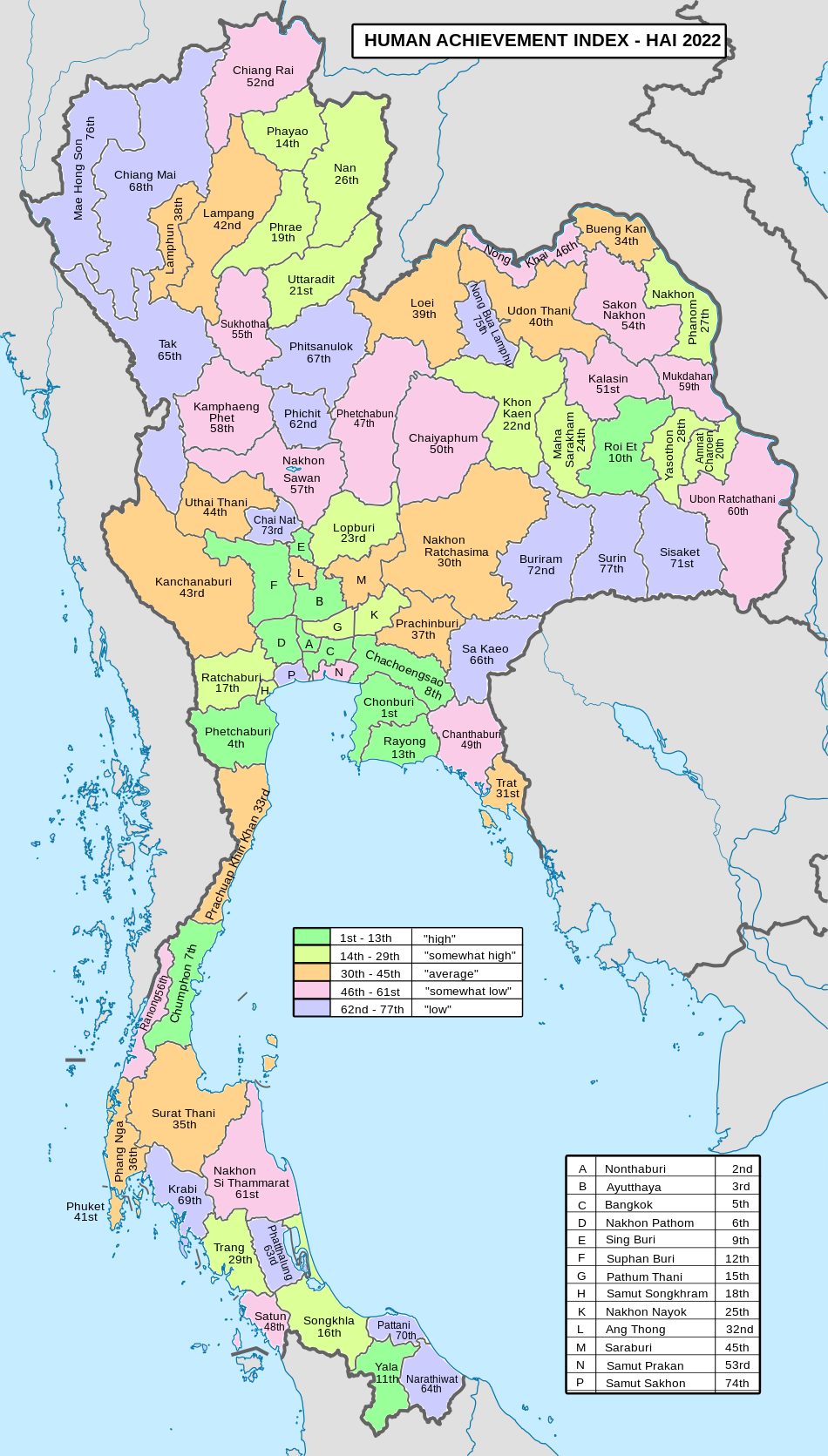
|
Transportation
[edit]
- Road: Chiang Mai is on Highway 11, the only 2-digit road number in the province. Other roads connect the city of Chiang Mai with the north and south of the province, as well as with the east towards Chiang Rai province.
- Train: Chiang Mai railway station is the northern terminus of the Northern Line, operated by the State Railway of Thailand.
- Air: Chiang Mai International Airport (CNX) is one of the seven Thai international airports under the aegis of the Airports of Thailand Public Company Limited (AOT).[23] As Chiang Mai International Airport is the major gateway to northern Thailand, it plays an important role in promoting travel and tourism throughout the northern region. Today, 14 airlines serve the airport and more than 3,000,000 passengers, 15,000 flights, and 16,000 tons of cargo are handled annually.[citation needed]*Songthaew
Tourism
[edit]This article is written like a travel guide. (February 2020) |
Chiang Mai province is the tourist hub of the north and one of Thailand's most important tourist destinations.[citation needed] It is considered one of the most scenic provinces in the country due to its mountain ranges, valleys, flora, and fauna. For example, the Hang Dong Canyon is coveted as a great tourist attraction. Furthermore, unlike most of Thailand, in some months, the climate in the north and Chiang Mai is cool, fresh, and misty.
Health
[edit]Each amphoe of Chiang Mai has its own hospital, but among the largest are located in Mueang Chiang Mai District and include Maharaj Nakorn Chiang Mai Hospital and Nakornping Hospital.
Local products
[edit]Chiang Mai is a handicrafts centre, with a variety of antiques, silver jewellery, and embroidery, Thai silks and cottons, basketry, celadon, silverware, furniture, lacquerware, woodcarvings, and parasols.[24]
Local culture
[edit]The north of Thailand's culture is Lanna in origin and the people are proud of their northern roots. The region is home to distinctive foods, music, arts, way of life, and even language. Chiang Mai is home to various hill tribes and their own distinctive cultures.
Local food
[edit]
- Nam phrik ong is a type of Nam phrik chili paste which is made of minced pork and tomatoes. It is usually eaten with soft-boiled vegetables, pork crackling, or deep-fried crunchy rice cakes.
- Nam phrik num meaning "chili paste young man", is another kind of paste which can be eaten with pork crackling.
- Sai ua is a local sausage that is very aromatic and spicy and is usually eaten with sticky rice.
- Kaeng meaning "curry", is not made with coconut milk in the north.
- Kaeng hang-le is northern-style pork curry
- Kaeng om is a spicy curry consisting of intestines
- Kaeng khae is a spicy curry consisting mainly of vegetables.
- Khanom chin nam ngiao is a traditional northern noodle dish with chicken or pork.
- Khao soi is a noodle dish which can be made from chicken, pork, or beef made with coconut milk and garnished with chopped fresh shallots, pickled cabbage, chilli paste to taste, and a slice of fresh lime.
Sports
[edit]There are two main sport stadia in Chiang Mai and its environs: 700th Anniversary Stadium and Province Stadium. 700th Anniversary Stadium is on Klongchonpratan Road, 7 km (4.3 mi) from Chiang Mai University. There are swimming pools, diving pool, basketball arena, and 11 tennis courts.
-
Chiang Mai, Yi Peng Festival
-
People floating krathong rafts during the Loi Krathong festival in Chiang Mai
Sister cities
[edit]The province is twinned with eight provinces/states.[25]
 Shanghai, China (2000)
Shanghai, China (2000) Yogyakarta, Indonesia (2007)
Yogyakarta, Indonesia (2007) Qingdao, China (2008)
Qingdao, China (2008) Chongqing, China (2008)
Chongqing, China (2008) Hokkaido, Japan (2013)[26]
Hokkaido, Japan (2013)[26] Bursa, Turkey (2013)
Bursa, Turkey (2013) Chiang Tung, Myanmar (2014)[27]
Chiang Tung, Myanmar (2014)[27] Chengdu, China (2015)
Chengdu, China (2015)
Notable inhabitants
[edit]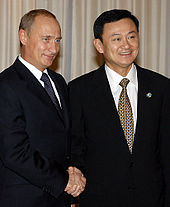
- Thaksin Shinawatra (Thai: ทักษิณ ชินวัตร) (born 1949), politician and businessman
- Yingluck Shinawatra (Thai: ยิ่งลักษณ์ ชินวัตร) (born 1967), politician
Gallery
[edit]-
The viewpoint at the 41st km of the Highway 1009, Doi Inthanon
-
Prunus cerasoides blooming at Doi Suthep–Pui National Park
-
Pong Dueat Hot Springs, Huai Nam Dang National Park
-
Ob Khan National Park
-
Mae Wang National park
-
Doi Chiang Dao mountain
-
The mountains of Chiang Dao Wildlife Sanctuary in Chiang Dao District
-
A photo of a hill blue flycatcher in the Chiang Dao Wildlife Sanctuary
-
Bathing elephants in the Taeng River
-
Mae Thun Noi, Omkoi
-
The Fang River, part of the Mekong watershed, in Chai Prakan District
-
The lake of Mae Ngat Somboon Chon Dam, Si Lanna National Park
-
East gate (Tha Phae Gate) of the city wall
-
Shopping Mall in Chiang Mai
-
Thaton countryside
-
Hmong girls
-
The "flame of the forest"
Notes
[edit]- ^ Thai: เชียงใหม่, pronounced [tɕʰīaŋ màj] ; Northern Thai: ᨩ᩠ᨿᨦᩉᩲ᩠ᨾ᩵ เจียงใหม่, pronounced [tɕīaŋ màj]
References
[edit]- ^ "รายนามผู้ว่าราชการจังหวัด" [List of Governors of Provinces of Thailand] (PDF). Ministry of Interior (Thailand). 2 December 2022. Retrieved 8 January 2023.
- ^ a b "ตารางที่ 2 พี้นที่ป่าไม้ แยกรายจังหวัด พ.ศ.2562" [Table 2 Forest area Separate province year 2019]. Information, Forest statistics Year 2019, Thailand boundary from Department of Provincial Administration in 2013 (in Thai). Royal Forest Department. 2019. Retrieved 6 April 2021.
- ^ a b ประกาศกระทรวงมหาดไทย เรื่อง การกำหนดเขตตำบลในท้องที่อำเภอสามเงา จังหวัดตาก (ฉบับที่ ๒) พ.ศ. ๒๕๖๓
- ^ a b ประกาศกระทรวงมหาดไทย เรื่อง การกำหนดเขตตำบลในท้องที่อำเภอดอยเต่า จังหวัดเชียงใหม่ (ฉบับที่ ๒) พ.ศ. ๒๕๖๗
- ^ a b รายงานสถิติจำนวนประชากรและบ้านประจำปี พ.ส.2562 [Statistics, population and house statistics for the year 2019]. Registration Office Department of the Interior, Ministry of the Interior. stat.bora.dopa.go.th (in Thai). 31 December 2019. Archived from the original on 14 June 2019. Retrieved 26 February 2020.
- ^ a b "ข้อมูลสถิติดัชนีความก้าวหน้าของคน ปี 2565 (PDF)" [Human Achievement Index Databook year 2022 (PDF)]. Office of the National Economic and Social Development Council (NESDC) (in Thai). Retrieved 12 March 2024, page 27
{{cite web}}: CS1 maint: postscript (link) - ^ "Gross Regional and Provincial Product, 2019 Edition". <>. Office of the National Economic and Social Development Council (NESDC). July 2019. ISSN 1686-0799. Retrieved 22 January 2020.
- ^ "Doi Inthanon National Park". Tourist Authority of Thailand (TAT). Archived from the original on 1 May 2015. Retrieved 21 Mar 2015.
- ^ "Doi Suthep-Pui National Park". Department of National Parks (DNP) Thailand. Archived from the original on 24 May 2015. Retrieved 24 May 2015.
- ^ "Ob Luang National Park". Department of National Parks (DNP) Thailand. Archived from the original on 9 November 2013. Retrieved 24 May 2015.
- ^ "Si Lanna National Park". Department of National Parks (DNP) Thailand. Archived from the original on 24 May 2015. Retrieved 24 May 2015.
- ^ "Huai Nam Dang National Park". Tourism Authority of Thailand (TAT). Archived from the original on 2 April 2015. Retrieved 21 Mar 2015.
- ^ "Mae Wang National Park". Department of National Parks (DNP) Thailand. Archived from the original on 12 February 2015. Retrieved 24 May 2015.
- ^ "Pha Daeng National Park". Department of National Parks (DNP) Thailand. Archived from the original on 24 May 2015. Retrieved 24 May 2015.
- ^ a b c d e f g h i j k "ข้อมูลพื้นที่อุทยานแห่งชาติ ที่ประกาศในราชกิจจานุบกษา 133 แห่ง" [National Park Area Information published in the 133 Government Gazettes]. Department of National Parks, Wildlife and Plant Conservation (in Thai). December 2020. Archived from the original on 3 November 2022. Retrieved 1 November 2022.
- ^ a b c d "ข้อมูลพื้นที่อุทยานแห่งชาติ (เตรียมการ) 22 แห่ง" [Information of 22 National Parks Areas (Preparation)]. Department of National Parks, Wildlife and Plant Conservation (in Thai). December 2020. Archived from the original on 3 November 2022. Retrieved 1 November 2022.
- ^ a b c d "ตาราง 5 พื้นที่เขตรักษาพันธุ์สัตว์ป่า พ.ศ. 2562" [Table 5 Wildlife Sanctuary Areas in 2019] (PDF). Department of National Parks, Wildlife Sanctuaries and Plant Conservation (in Thai). 2019. Retrieved 1 November 2022.
- ^ "Daily Climate Weather Data Statistics". Geodata.us. Retrieved 2012-04-29.
- ^ "Chiang Mai". Tourism Authority of Thailand (TAT). Archived from the original on 30 March 2015. Retrieved 21 Mar 2015.
- ^ a b c "Office of the Royal Society" (in Thai). Section เชียงใหม่.
- ^ The code 25 was assigned to a planned district named Wiang Kham, which however wasn't created.
- ^ "Number of local government organizations by province". dla.go.th. Department of Local Administration (DLA). 26 November 2019. Retrieved 10 December 2019.
13 Chiang Mai: 1 PAO, 1 City mun., 4 Town mun., 116 Subdistrict mun., 89 SAO.
- ^ "Chiang Mai International Airport". Airports of Thailand Public Co., Ltd. Archived from the original on 4 December 2016. Retrieved 24 May 2015.
- ^ "Shopping Chiang Mai". Tourism Authority of Thailand (TAT). Archived from the original on 24 May 2015. Retrieved 24 May 2015.
- ^ "Archived copy" (PDF). Archived from the original (PDF) on 2015-09-23. Retrieved 2016-06-23.
{{cite web}}: CS1 maint: archived copy as title (link) - ^ "MOU of the Establishment of Friendship between Province of Chiang Mai and Prefecture of Hokkaido" (PDF). Retrieved 2018-12-29.
- ^ "ประยุทธ์เยือนพม่า-ขอสื่ออย่าระบุสัญชาติผู้ต้องหาเกาะเต่า".











